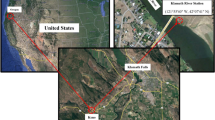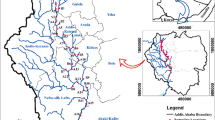Abstract
In this study, a device to diffuse the flow of water in a horizontal direction was installed over a small river connected to Nakdonggang River and the dissolved oxygen (DO) concentration within the range of its influence was monitored. A DO probe was installed and operated at three depths of water; the surface layer, middle layer and deep layer. In order to judge stagnant water by operating and controlling the device automatically, an artificial neural network model that worked through profiling by logics and expert learning was applied. For expert learning, the number of all cases generated from DO data was labeled based on expert judgment. In other words, when DO concentration was divided into 7 levels, the number of cases was 343, the experts were requested to determine whether each case was a stagnant water. Machine learning was carried out targeting labelling by experts with the artificial neural network (ANN) and the convolution neural network (CNN). The target datasets for learning were 3 × 1 based on numbers from 1 to 7 and 7 × 7 based on the dot graph. The correct ratio for the ANN model learning result based on the graph was only 29.2%, so it was excluded. The correct ratio for the ANN model learning result based on numbers was 87.2%. The correct ratio for the CNN based on the graph was 94.2%. When machine learning was carried out with 30 to 300 randomly selected targeted graphs, the ANN model showed 74.6% as the correct ratio for up to 150 graphs, which was somewhat low, while the CNN showed 84.3% for 30 graphs and 94.2% for 200 graphs, a gradual increase with results comparable to the total number of graphs. By applying the relevant control logics to actual monitoring results, 91.5% and 87.4% was judged to be stagnant water from points directly and indirectly affected by the device, respectively.








Similar content being viewed by others
Availability of Data and Material
Available upon request.
References
Aichouri I, Hani A, Bougherira N, Djabri L, Chaffai H, Lallahem S (2015) River Flow Model Using ArtificialNeural Networks. Energy Procedia 74:1007–1014
Arias-Rodriguez L, Duan Z, Sepúlveda R, Martinez-Martinez S, Disse M (2020) Monitoring Water Quality ofValle de Bravo Reservoir, Mexico, Using Entire Lifespan ofMERIS Data and Machine Learning Approaches, Remotesensing, 12(10):1586–1611
Baek S, Pyo J, Chun J (2020) Prediction of Water Level and Water Quality Using a CNN-LSTM Combined Deep Learning Approach, Water, 12:3399
Barton D, Sundt H, Bustos A, Fjeldstad H, Hedger R, Forseth T, Köhler B, Aas Ø, Alfredsen K, Madsen A (2020) Multi-criteria decision analysis in Bayesian networks - Diagnosing ecosystem service trade-offs in a hydropower regulated river. Environ Model Softw 124:104604
Chen H, Chen A, Xu L, Xie H, Qiao H, Lin Q, Cai K (2020) A deep learning CNN architecture applied in smart near-infrared analysis of water pollution for agricultural irrigation resources. Agric Water Manage 240(1):106303
Cigizoglu H (2008) Artificial Neural Networks In Water Resources, Integration of Information for Environmental Security, 115–148
Farfán J, Palacios K, Ulloa J, Avilés A (2020) A hybrid neural network-based technique to improve the flow forecasting of physical and data-driven models: Methodology and case studies in Andean watersheds. J Hydrology: Reg Stud 27:100652
Iliadis L, Maris F (2006) An Artificial Neural Network model for mountainous water-resources management: The case of Cyprus mountainous watersheds. Environ Model Softw 22(7):1066–1072
Peterson J, Freeman M (2016) Integrating modeling, monitoring, and management to reduce critical uncertainties in water resource decision making. J Environ Manage 183(2):361–370
Jang Y, Lim H, Jung J, Park J, Chang H, Park N, Kim W (2018) Water Quality Improvement of Non-PoweredWater Circulation System for Shallow Reservoirs. J Kor Soc Environ Eng 40(11):438–446
KICT (2013) “Real time monitoring system using waterdepth profile in stagnant stream channel”, KICT report,2013 – 214:37–38
Lasdon L, Fox R, Ratner M (1974) Nonlinear optimizationusing the generalized reduced gradient method. R A I R O Recherche Opérationnelle 8(3):73–103
Lee J, Kim I (2015) Water Quality Monitoring of Changnyeong-Hamahn Weir: With Chlorophyll a and Nutrients. J Korean Soc UrbanEnvironment 15(2):93–100
Lee S, Kim B, Lee H (2014) A Study on Water Qualityafter Construction of the Weirs in the Middle Area inNakdong River. J Kor Soc Environ Eng 36(4):258–264
Lee Y, Lee K (2004) Organic Sediment Distribution andRelease Characteristics on Lake Deachung. J Kor Soc Environ Eng 26(6):665–669
Lee J, Kim I (2020) Improvement of Water Quality byMonitoring and Identification of Stagnation usingConvolution Neural Network Model. KSWST Jour Wat Treat 28(5):69–77
Makoto Higashino (2011) Oxygen consumption by a sediment bed for stagnant water: comparison to SOD with fluid flow. Water Res 45(15):4381–4389
Mandap J, Sze D, Reyes G, Dumlao S, Reyes R, Chung W (2018) Aquaponics pH Level, Temperature, and Dissolved Oxygen Monitoring and Control System Using Raspberry Pi as Network Backbone, TENCON 2018–2018 IEEE Region 10 Conference, 1381–1386
Nguyen B, Rittmann B (2018) Low-cost optical sensor to automatically monitor and control biomass concentration in microalgal cultivation. Algal Res 32:101–106
Nisar M, Ross K, Brown M, Bentham R, Whiley H (2020) Water Stagnation and Flow Obstruction Reduces the Quality of Potable Water and Increases the Risk of Legionelloses,Frontiers in Environmental Science, 8:Article 611611.
Paerl H, Gardner W, Havens K, Joyner A, McCarthy M, Newell S, Qin B, Scott J (2016) Mitigating cyanobacterialharmful algal blooms in aquatic ecosystems impacted byclimate change and anthropogenic nutrients, HarmfulAlgae, 54:213–222
Park C, Chung I (2020) Evaluating the groundwaterprediction using LSTM model. J Korea WaterResources Association 53(4):273–283
Park S (2012) Algal blooms hit South Korean rivers. Nature https://doi.org/10.1038/nature.2012.11221
Postolache O, Girao P, Pereira M, Ramos H (2002) An Internet and microcontroller-based remote operation multi-sensor system for water quality monitoring, SENSORS, 2002 IEEE, 2:1532–1536
Ray P, Brown C (2015) Confronting Climate Uncertainty in Water Resources Planning and Project Design: The Decision Tree Framework. World Bank, Washington, DC
Russakovsky O, Deng J, Su H, Krause J, Satheesh S, MaS (2015) Imagenet large scale visual recognitionchallenge. Int J Comput Vision 15(3):211–252
Ryu I, Yu S, Chung S (2020) Characterizing Density FlowRegimes of Three Rivers with Different PhysicochemicalProperties in a Run-Of-The-River Reservoir. Water 12(3):717–737
Schulze F, Wolf H, Jansen H, van der Veer P (2005) Applications of Artificial Neural Networks in integratedwater management: fiction or future? Water Sci Technol 52(9):21–31
Shrestha M, Manandhar S, Shrestha S (2020) Forecasting water demand under climate change using artificial neural network: A case study of Kathmandu Valley, Nepal. Water Sci Technology: Water Supply 20(5):1823–1833
Valueva M, Nagornov N, Lyakhov P, Valuev G, ChervyakovN (2020) Application of the residue number system toreduce hardware costs of the Convolution Neural Networkimplementation. Math Computers inSimulation 177:232–243
WHO (World Health Organization), Management ofcyanobacteria in drinking-water supplies: Information forregulators and water suppliers, WHO reference number:WHO/FWC/WSH/15.03 (2015)
Yamashita R, Nishio M, Do R, Togashi K (2018) Convolutional neural networks: an overview and application in radiology. Insights Imaging 9:611–629
Yeo W, Heo C, Lee S, Jee H (2006) Aquatic Plant Restoration by Mattress/Filter System in Stagnant Stream Channel. J Environ Sci Int 15(1):21–31
Zhou T, Dong Z, Chen X, Ran Q (2021) Decision Support Model for Ecological Operation of Reservoirs Based on Dynamic Bayesian Network. Water 13(12):1658
Ziemińska-Stolarska A, Imbierowicz M, Jaskulski M, Szmidt A, Zbiciński I (2019) Continuous and PeriodicMonitoring System of Surface Water Quality of anImpounding Reservoir: Sulejow Reservoir. Pol Int J Environ Res andPublic Health 16(3):301–317
Zlatanović L, van der Hoek J, Vreeburg J (2017) An experimental study on the influence of water stagnation and temperature change on water quality in a full-scale domestic drinking water system. Water Res 123:761–772
Acknowledgements
This work is supported by the Korea Institute of Civil Engineering and Building Technology, KICT, of Korean Government number 2020-0054.
Funding
This work is supported by the Korea Institute of Civil Engineering and Building Technology, KICT, of Korean Government number 2020-0054.
Author information
Authors and Affiliations
Contributions
JY Lee (Senior Researcher and Associate Professor) conducted all the experiments and wrote the manuscript. IH Kim (Research Fellow and Professor) wrote and revised the manuscript.
Corresponding author
Ethics declarations
Ethics Approval
Not applicable.
Consent to Participate
Not applicable.
Conflicts of Interest/Competing Interests
None.
Additional information
Publisher’s Note
Springer Nature remains neutral with regard to jurisdictional claims in published maps and institutional affiliations.
Rights and permissions
About this article
Cite this article
Lee, J., Kim, I. Long-term stagnation monitoring using machine learning: comparison of artificial neural network model and convolution neural network model. Water Resour Manage 36, 2117–2130 (2022). https://doi.org/10.1007/s11269-022-03120-5
Received:
Accepted:
Published:
Issue Date:
DOI: https://doi.org/10.1007/s11269-022-03120-5




